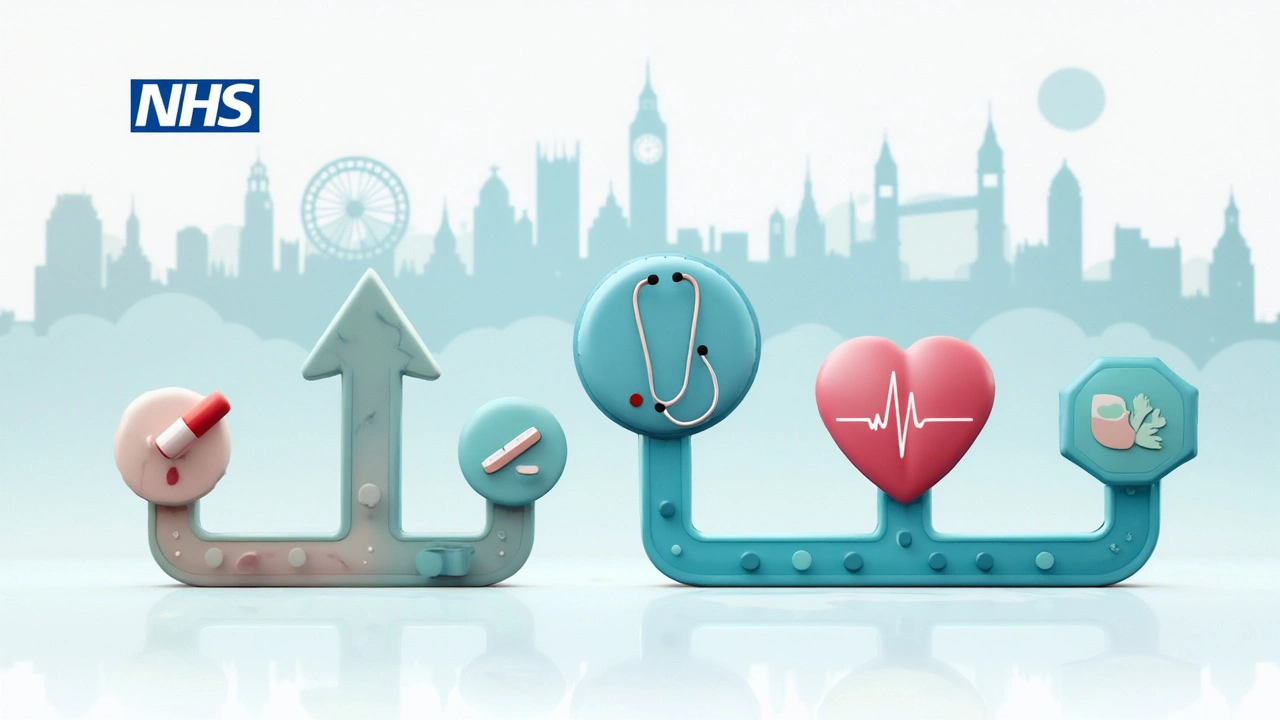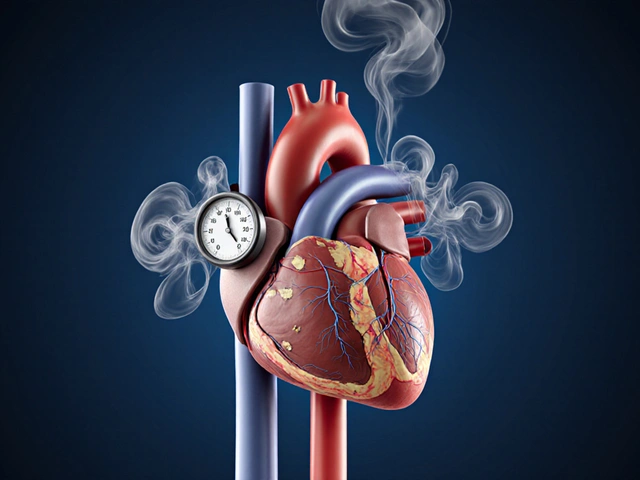If Simvastatin just isn’t working for you or your body can’t deal with the side effects, you have plenty of options—each with its own perks and quirks. Cholesterol meds come in all styles now: quick pills, regular shots, and combo strategies that don’t always fit inside the old statin box. It doesn’t matter if you’re dealing with muscle pain, looking for max cholesterol drop, or just want something easier on the wallet—there’s a backup plan.
Let’s break down the most talked-about alternatives to Simvastatin, what makes each one tick, and who might actually see a benefit. You’ll get the straight-up pros and cons, with a few tips to dodge common pitfalls. This isn’t guesswork or hype; it’s the real stuff patients and doctors use every day.
- PCSK9 Inhibitors (Repatha, Praluent)
- Atorvastatin (Lipitor)
- Rosuvastatin (Crestor)
- Ezetimibe (Zetia)
- Bile Acid Sequestrants
- Comparison and Summary
PCSK9 Inhibitors (Repatha, Praluent)
One of the game-changers for people who can't lower their cholesterol enough with simvastatin or other statins? PCSK9 inhibitors like Repatha and Praluent. These are shots, not pills, and they do a different job. Instead of slowing cholesterol production in your liver, they block a protein called PCSK9. That means your liver can suck even more LDL (the "bad" cholesterol) out of your blood.
Here’s how effective these drugs can be: In big trials, people using Repatha or Praluent saw their LDL drop by 50% to 60% on top of other cholesterol meds. That’s huge—especially if you’ve got a dangerously high cholesterol level or you’re at big risk for heart attack or stroke. They’re especially useful for folks with a genetic cholesterol disorder called familial hypercholesterolemia or those who’ve already had a heart event and desperately need lower LDL numbers.
| PCSK9 Inhibitors | How Taken | Typical LDL Reduction |
|---|---|---|
| Repatha / Praluent | Injection every 2 or 4 weeks | Up to 60% |
One thing to know: These aren’t your bargain-bin meds. PCSK9 inhibitors can run thousands of dollars a year, even after insurance and coupons. And you have to inject them yourself—usually in your thigh, belly, or arm—every 2 or 4 weeks, depending on the brand and dose. Doctors usually save these for people in real need, not just those with mildly elevated cholesterol.
Pros
- LDL cholesterol drops big-time—better than any statin alternative on the market right now.
- Ideal if you can’t tolerate statins or have a genetic cholesterol disorder.
- No muscle aches—the side effects people hate about statins.
Cons
- Very expensive—even with insurance, out-of-pocket costs can sting.
- Need to inject yourself, which is a turn-off for a lot of people.
- Not as easy to get—a doctor usually has to prove you really need it.
Bottom line? If you need something way stronger than simvastatin, and you’re okay with shots and the price tag, PCSK9 inhibitors might be your ticket to seriously better heart health.
Atorvastatin (Lipitor)
Atorvastatin is a top pick for people who need a heavy-hitter to lower LDL cholesterol. You’ll see it in millions of prescriptions – in fact, it’s one of the most commonly used statins out there. It’s actually stronger, milligram-for-milligram, than simvastatin. Doctors often nudge patients to try it if they need a bigger drop in their numbers or if they can’t push simvastatin any higher because of side effects.
This drug works by cranking down the stuff your liver uses to make cholesterol in the first place. It’s been around since the late ’90s and has a ton of research backing up its safety for most people, whether you’re on it for a few months or decades. If you’re watching your cholesterol for heart health or stroke prevention, this one often lands near the top of the list.
Here’s a quick look at how atorvastatin stacks up for those considering making the switch from simvastatin:
Pros
- More effective at lowering LDL (bad cholesterol) compared to most other statins at similar doses.
- Reduces risk of heart attacks, strokes, and even some forms of heart failure by keeping cholesterol under control.
- Comes in a range of dosages—ten mg all the way up to eighty mg, so you can fine-tune the amount easily.
- Available as a generic, so it’s affordable for most people and covered by nearly every insurance plan.
- Can be taken any time of the day, with or without food.
Cons
- Common statin side effects like muscle aches or mild weakness can still happen, though most people do fine.
- May raise blood sugar in a small number of folks, especially if you’re already at risk for diabetes.
- Potential for drug interactions—especially with some antibiotics and antifungals. Always check with your doctor if you start something new.
- Not a fit for people with serious liver disease.
Lots of people want to know just how big a difference atorvastatin can make with their cholesterol. Here’s a ballpark comparison for moderate to high doses versus simvastatin, based on a key clinical trial:
| Drug | Common Dose | Average LDL Reduction |
|---|---|---|
| Simvastatin | 40 mg | ~36% |
| Atorvastatin | 40 mg | ~47% |
If you’ve struggled to hit your cholesterol target and need something with a better punch but don’t want to jump to injections, atorvastatin could be the next practical move. Just keep an eye out for typical statin issues, and loop in your provider if anything feels off.
Rosuvastatin (Crestor)
If you’re looking for something a notch stronger than Simvastatin, Rosuvastatin—most folks know it as Crestor—usually sits high on the list. It’s a statin, just like Simvastatin, but it packs a little more punch when you need to drop those LDL cholesterol numbers fast. Crestor’s been around for years, and doctors reach for it when patients have high cholesterol that stubbornly sticks around, even with diet tweaks and exercise.
The dose flexibility is a real win. Some people only need a low dose (5mg), which can mean fewer side effects, while others might need the heavy-hitting 40mg for maximum effect. Rosuvastatin also doesn’t interact with grapefruit the way some statins do—a weird, but real, perk for citrus lovers.
| Drug | Typical LDL Reduction | Usual Starting Dose |
|---|---|---|
| Simvastatin | 25-35% | 20mg |
| Rosuvastatin | 38-55% | 10mg |
Plus, there’s some evidence that Rosuvastatin can help lower triglycerides and slightly raise HDL cholesterol (‘good’ cholesterol). Researchers even found this statin can slow down plaque buildup in arteries better than some older statins.
Pros
- Lowers LDL cholesterol more than many other statins—including simvastatin.
- Flexible dosing lets doctors tweak your amount for best results.
- Less likely to react with certain foods or other drugs.
- Evidence for slowing plaque in arteries, not just dropping numbers on a lab test.
Cons
- Muscle aches and weakness can still show up—the risk goes up with higher doses or if you mix with certain meds.
- It’s pricier than generic simvastatin, though generic rosuvastatin is making this less of an issue lately.
- May mess with blood sugar, especially in people already teetering on the edge of diabetes.
- Routine bloodwork is a must to keep an eye on liver enzymes and muscle health.
Rosuvastatin is a solid middle ground—stronger than Simvastatin, reliable, and used by millions. If you need bigger results and want to avoid some of the food and drug headaches of older statins, Crestor might be worth a chat with your doctor.

Ezetimibe (Zetia)
If you’re looking for something that isn’t a statin but still knocks down cholesterol numbers, ezetimibe—the generic name for Zetia—could be your pick. It’s taken as a pill once a day, just like Simvastatin. Ezetimibe works differently, though: instead of blocking cholesterol production in the liver, it keeps your intestines from soaking up that extra cholesterol from food. The result? Less cholesterol floating around in your blood.
Ezetimibe is usually not the first thing a doctor grabs for—most folks start with statins. But if you’re having muscle aches, can’t tolerate statins, or your levels won’t budge enough, ezetimibe is a pretty common next move. It’s safe for long-term use and plays nicely with statins if you ever need a combo punch against stubborn LDL (that’s the “bad” cholesterol).
Here’s how Ezetimibe stacks up:
Pros
- Very few side effects—most people don’t feel anything at all.
- Can lower LDL cholesterol by about 18-25%, which isn’t massive, but it’s steady and predictable.
- No muscle pain or weakness issues like statins sometimes cause.
- Works well with statins if you need a combination approach.
- Easy daily oral pill; no injections or special timing.
Cons
- Not as powerful alone as high-dose statins or PCSK9 inhibitors. If your LDL is sky-high, you’ll likely need more than just Zetia.
- Some folks report mild stomach upset or diarrhea, but it’s uncommon.
- It doesn’t budge triglycerides or HDL much—mainly targets LDL cholesterol.
Want a numbers snapshot? Here’s what the IMPROVE-IT trial found using ezetimibe with a statin versus a statin alone:
| Treatment | LDL-C Reduction (%) | Heart Event Risk |
|---|---|---|
| Statin Only | ~50% | Baseline |
| Statin + Ezetimibe | ~63% | Lowered by 6-7% |
Bottom line: If a simple daily pill with almost no side effects sounds good, Ezetimibe is a solid backup plan when simvastatin doesn’t cut it. If you need big numbers, it pairs up well with a statin—kind of like having bacon and eggs together instead of just toast.
Bile Acid Sequestrants
Bile acid sequestrants are old-school but still trusted for lowering cholesterol when statins like Simvastatin don’t fit the bill. These meds, like cholestyramine (Questran), colestipol (Colestid), and colesevelam (Welchol), grab cholesterol-rich bile acids in your gut. That forces your body to use up extra cholesterol from your blood, dropping those numbers over time.
Doctors have used these for decades, especially in folks who can’t handle statins due to muscle aches or interactions with other drugs. They don’t work like a lightning bolt—think of it as a slow-but-steady approach. One upside: they rarely get into your blood, so side effects often stick to the gut (bloating, constipation).
"Bile acid sequestrants remain a go-to option for patients with mild to moderate LDL elevation who struggle with statin tolerance or drug interactions." — Cleveland Clinic Journal of Medicine
Combination therapy is also common. Sometimes docs pair bile acid sequestrants with statins or ezetimibe for a double whammy, pushing LDL even lower without extra side effects.
Pros
- No muscle or memory side effects like traditional statins
- Can safely combine with other cholesterol meds
- Helpful for younger patients and pregnant women who need to avoid statins
- Rarely absorbed, so minimal risk to the liver or kidneys
Cons
- Bloating, gas, and constipation are pretty common
- Not as strong as statin alternatives for big drops in LDL
- Needs to be taken with food and a lot of water
- Can interfere with absorption of other medications—timing is key
| Drug Name | Typical LDL Reduction (%) | Main Side Effects |
|---|---|---|
| Cholestyramine | 15-20 | Constipation, bloating |
| Colestipol | 15-20 | Gas, fullness |
| Colesevelam | 15-18 | Constipation, upset stomach |
Doctors usually suggest bile acid sequestrants if you’ve hit a wall with Simvastatin or need lighter side effects. It’s not a new trick, but for some folks it’s exactly the right move for safer heart health.
Comparison and Summary
If Simvastatin isn't clicking with you, it's smart to see how the main simvastatin alternatives stack up. You want the biggest drop in LDL? Or maybe you care more about price, side effects, or just not having to deal with shots. There’s no one-size-fits-all—each option comes with its own set of trade-offs.
| Alternative | How It's Used | LDL Reduction | Main Pros | Main Cons |
|---|---|---|---|---|
| PCSK9 Inhibitors (Repatha, Praluent) | Injection every 2-4 weeks | Up to 60% | Massive LDL drop, good for toughest cases | High cost, not easy to get, needles |
| Atorvastatin (Lipitor) | Daily pill | 35-55% | Strong track record, generic versions | Can cause side effects like any statin |
| Rosuvastatin (Crestor) | Daily pill | 45-63% | Higher potency, often works when others don’t | Still a statin, costlier if not generic |
| Ezetimibe (Zetia) | Daily pill | 18-25% | Low side effect risk, works with statins | Not as strong alone, may need to combine |
| Bile Acid Sequestrants | Powder or pills, 1-2x daily | 15-25% | Safe for many, no statin muscle issues | Can cause stomach issues, messy or bland taste |
Notice how PCSK9 inhibitors absolutely crush LDL cholesterol—sometimes by more than half—but you pay with higher cost and the hassle of shots. Statins like Atorvastatin and Rosuvastatin are heavy hitters with straightforward dosing, but some people can’t stand the side effects. Ezetimibe is gentler, especially if you already had trouble with statins, but usually isn’t enough on its own if your cholesterol is through the roof. Old-school bile acid sequestrants are safe but can be a pain to mix and swallow every day.
Tips if you’re switching from Simvastatin:
- Let your doctor know if you had side effects or weren’t getting results—it impacts which switch makes sense.
- Don’t jump to the strongest drug right away; often, combos (like Ezetimibe plus a low-dose statin) do the trick with fewer issues.
- Insurance coverage for newer meds like PCSK9 inhibitors is tight—get ready for paperwork.
- If side effects were your main headache, ask about non-statin options first.
The best move? Figure out what matters most to you—then match it with the right alternative. That way, your cholesterol goes down and your quality of life goes up.






tierra hopkins
23 April 2025Switching from Simvastatin can feel like stepping into a maze, but there are solid road‑maps out there. PCSK9 inhibitors give a massive LDL drop if you can handle the injection routine and the price tag. If injections feel daunting, Atorvastatin or Rosuvastatin are strong pill options that many tolerate well. Ezetimibe is a gentle side‑kick that works nicely with a low‑dose statin and hardly ever causes muscle pain. For folks who want to stay clear of any statin‑related aches, bile‑acid sequestrants are a tried‑and‑true gut‑focused choice. Talk with your doctor about your personal risk factors, insurance coverage, and how each alternative fits your lifestyle. Remember, the goal is a sustainable plan that keeps your cholesterol in check without sacrificing quality of life.
Ryan Walsh
23 April 2025If you can’t stand the muscle aches, just try the pill‑only options first.
Kiersten Denton
23 April 2025I've been on Simvastatin for years and the muscle soreness finally got too much, so I switched to a low‑dose Atorvastatin. The change was smooth and my blood work showed a better LDL drop without the aches. It’s worth chatting with your cardiologist about a gradual switch.
Karl Norton
23 April 2025Honestly, that oversimplified advice ignores the fact that many patients need more than just a "pill‑only" swap. The nuances of drug interactions, kidney function, and genetic factors mean a blanket suggestion can be dangerous. Doctors should evaluate each case individually rather than tossing out one‑liner advice.
Ashley Leonard
23 April 2025When weighing options, consider both efficacy and side‑effect profile. PCSK9 inhibitors are fantastic for high‑risk patients but the cost can be a barrier; some insurers require prior authorizations that take weeks. Atorvastatin offers a solid middle ground with strong LDL reduction and generic affordability. Rosuvastatin adds potency with fewer food interactions, while Ezetimibe is almost side‑effect‑free and pairs well with a statin if you need extra push.
Ramanathan Valliyappa
23 April 2025PCSK9 inhibitors = high efficacy, high cost; statins = moderate efficacy, moderate side effects; ezetimibe = low efficacy, low side effects.
lucy kindseth
23 April 2025It’s great that you shared your personal switch, because real‑world experiences add valuable context beyond clinical trial data. Many patients discover that the “one‑size‑fits‑all” mentality doesn’t hold up when it comes to cholesterol management. For instance, while Atorvastatin is indeed more potent than Simvastatin, some individuals experience a rise in blood sugar that can tip them toward pre‑diabetes, especially at higher doses. Rosuvastatin, on the other hand, tends to have a cleaner interaction profile with common foods like grapefruit, which can be a relief for those who enjoy citrus. Bile‑acid sequestrants, though older, remain a viable option for patients who cannot tolerate any statin‑related muscle pain, but they require diligent timing with meals and other medications. Ezetimibe’s mechanism of blocking intestinal cholesterol absorption makes it a useful adjunct; many clinicians start with a low‑dose statin and add Ezetimibe when LDL targets aren’t met. The cost factor cannot be ignored – generic statins like Atorvastatin are typically covered, whereas PCSK9 inhibitors often need extensive insurance paperwork and may involve copays in the thousands. Some health systems have patient‑assistance programs that can mitigate these expenses, but eligibility varies widely. Lifestyle modifications, such as increased soluble fiber intake and regular aerobic exercise, still play a supportive role regardless of the pharmacologic choice. Moreover, regular monitoring of liver enzymes and CK levels helps catch adverse effects early, especially when escalating statin doses. If you experience persistent muscle discomfort, checking vitamin D levels can sometimes reveal a reversible contributor. In summary, the decision matrix involves efficacy, side‑effect tolerance, cost, and personal preferences, and the best outcome usually emerges from a shared decision‑making process with your provider. I encourage anyone feeling uneasy about a switch to keep a log of symptoms and lab results to discuss at follow‑up appointments. This proactive approach often uncovers patterns that inform the optimal regimen. Ultimately, the goal is to lower cardiovascular risk without compromising day‑to‑day well‑being.
Nymia Jones
23 April 2025One must remain vigilant regarding the pharmaceutical conglomerates that profit from perpetuating unnecessary dependence on high‑priced biologics; the very existence of PCSK9 inhibitors raises the specter of a profit‑driven agenda masquerading as medical advancement, compelling patients to surrender billions to corporate interests under the guise of health.
Karen McCormack
23 April 2025In the grand tapestry of human health, cholesterol is but a thread woven by both nature and nurture, and to yank at its fibers without regard for the surrounding weave risks unraveling the very fabric of our longevity; thus, the choice of a Simvastatin alternative should be guided not merely by statistics, but by a mindful contemplation of the symphony within.
Earl Hutchins
23 April 2025Statins hit the sweet spot for most patients; ezetimibe can fill gaps when statins fall short.
Tony Bayard
23 April 2025Picture this: you’re standing at a crossroads, one path lined with sleek injection pens promising a 60% LDL plunge, the other paved with humble tablets that whisper affordability and familiarity. The drama of choice can be overwhelming, but remember that drama fuels progress-every heart‑beat decision writes a new chapter in your health story. If the thought of needles makes you shudder, let the pill‑route be your ally; if you crave the most aggressive drop and can navigate insurance labyrinths, the injection route may be your hero. In any case, keep your doctor in the conversation, and let your personal values steer the helm.
Jay Crowley
23 April 2025Ezetimibe adds roughly 20% LDL reduction with minimal side effects.
sharon rider
23 April 2025The metaphor of cholesterol as a thread is evocative, yet practical considerations-such as drug interactions and renal function-must anchor our decisions. While poetic reflections inspire, clinicians require concrete data to guide prescriptions, balancing the art and science of therapy.
swapnil gedam
23 April 2025That concise figure captures the essence of Ezetimibe’s effect, but remember individual response can vary based on baseline LDL and concurrent therapies. It’s a solid option when you want a modest boost without adding statin‑related muscle concerns. Discuss with your provider whether it fits into a combination regimen for optimal results.